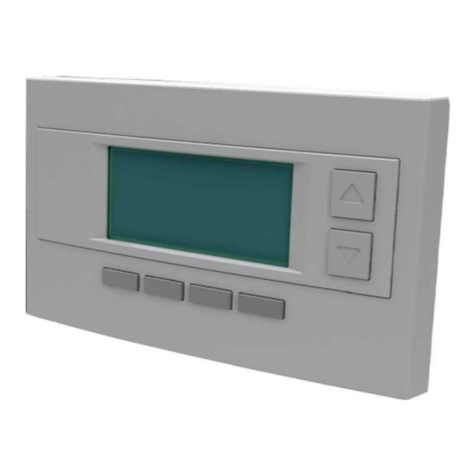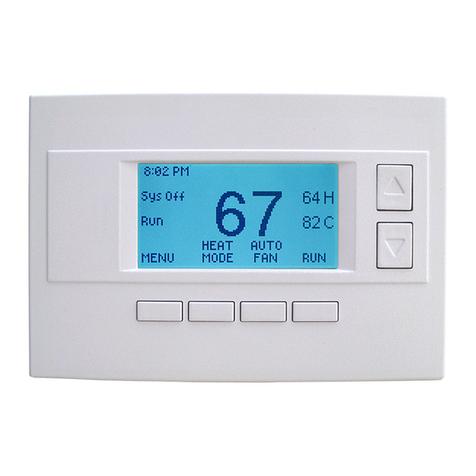DCN: 140-02338-01 DRAFT 20619
Page 10
To unlock the thermostat, press and hold the FAN button for 5 seconds to access the
Setup screen (it’s the only button that works in the lock mode). Access the Advanced
Settings Menu (as above) to turn the Display Lock off.
Test Mode Range Y or N Default: N
Test mode shortens the system built-in delays (like MOT and MRT)
Y= Test mode on. Reduces all delays to 10 sec for quicker system testing
N= Test mode off. Normal system delays
Aux Heat Enable (Heat Pump Systems only) Range: Y or N Default: Y
Enables the Auxiliary Heat operation.
Typically the Aux Heat will be heat-strips in a Heat Pump system
2nd Stage Heat Enable Range: Y or N Default: N
Enables the 2nd Stage Heat operation
2nd Stage Cool Enable Range: Y or N Default: N
Enables the 2nd Stage Cool operation
Minimum Run Time Range: 1- 9 Minutes Default: 3
Sets the Minimum Run Time (MRT) delay before a heating/cooling cycle can turn off.
Sets heating/cooling cycle time. Prevents rapid on/off cycling.
Minimum Off Time Range: 5-9 Minutes Default: 5
Sets the Minimum Off Time (MOT) delay before another heating/cooling cycle can begin.
Provides compressor short cycle protection. “WAIT” is displayed on screen when active.
Heat Setpoint Max Range: 30F to 109F (0C-43C)Default: 90F (32C)
Sets the maximum heating setpoint value.
Will not ramp or accept setpoints higher than this maximum.
Cool Setpoint Min Range: 33F to 112F (2C-45C)Default: 60F (15C)
Sets the minimum cooling setpoint value.
Will not ramp or accept setpoints lower than this minimum.
Heat Blower Off Delay Range: 0-90 seconds Default: 0 (off)
Sets the system blower delay off time after a heat call ends (fan purge).
Cool Blower Off Delay Range: 0-90 seconds Default: 0 (off)
Sets the system blower delay off time after a cool call ends (fan purge).
Heat - Cool Delta Range: 3 - 15 degrees. Default: 3F (1C)
Sets the minimum separation between heating and cooling setpoints.
Note! Attempts to lower the cooling setpoint below the heating setpoint will PUSH the
heating setpoint down to maintain this separation. The same applies to setting the heating
setpoint above the cooling setpoint, it will PUSH the cooling setpoint up to maintain the
setpoint delta separation.
Heating Stage 1 On Threshold Range: 1 to 6 degrees Default: 1
Sets the delta from setpoint that stage 1 heating starts.
Heating Stage 1 Off Threshold Range: 0 to 5 degrees Default: 0
Sets the delta from setpoint that stage 1 heating stops.
Stage 1 turns off at setpoint + Delta Stage 1.
Heating Stage 2 On Threshold Range: 2 to 7 degrees Default: 2





























